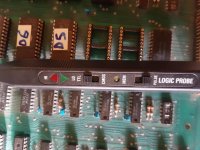Hugo,
This is the clearest explanation of the horizontal drive circuits that I have seen. Thanks so much for the diagram with the circuit analysis. I am not an analog guy so this really helps. I have printed it for my PET files.
-Dave
Dave,
I discovered this about the driver transformers in horizontal scan stages and also in some designs of switch mode power supplies many years ago. It came about as a result of a faulty switch mode power supply where its output, just from time to time dropped low, it fell out of regulation and shut down. The supply had been through the hands of a number of technicians before I was given it to repair (at a holiday job as a medical student I had to earn extra $) and practically all the parts on the pcb had been replaced, it still had the fault. It was a very very expensive item back then and the company who owned it wanted another go at fixing it.
In this case, the core of the driver transformer, made of two halves glued together, the glue had failed and the halves slightly separated, not easily visible to the eye
This drastically lowered the inductance of the transformer and the stored energy was reduced to the extent, that during the time the output transistor was supposed to be on, the base current dropped and the output transistor would start to come out of saturation and that is why it was failing to regulate and it was a borderline condition too. So I simply pulled it apart, clamped the core halves up with fresh glue and it was fixed. They paid me well and I got some more textbooks.
I'm generally good on analog circuits, and hard wired digital logic, but I struggle a lot on the software and the programming side of things.
Back on the topic of the PET monitor. For the most part I think it is fair to say if a computer was known at one point to be previously working, then it stops, most likely in all probability one fault has caused this.
The fault on the OP's PET monitor, the failure of Q13 and R34 likely was the primary problem and the rest of the computer is ok. What can happen though in attempts to repair assumed faults in other parts of the system by diving in too soon without test information that leads there, ends up creating more faults and the problem spirals out of control. We don't know much about the history of this PET, was it working before the monitor failed. Did any changes to the computer board (like changing IC's) result in failure of the monitor ? The history is always important in diagnosing a problem.
Since the horizontal drive signal is AC coupled into Q11 by the 0.1uF capacitor C16, even if that TTL level got stuck high or low due to a fault on the computer board, this would not result in the failure of Q13, so likely Q13 failed for another reason, perhaps if the signal presented was way higher in frequency than it should be, but that scenario is less likely. Its also possible that the other transistors associated with Q13 have failed, they all need checking in that area.
Of course its all very easy with a scope, but a person has to have one in the first place and be familiar with how to use it. So its pretty tricky for the OP to get the job done without one and just a meter (albeit possible), but that logic probe will help a lot.
Hugo.

